Contents
What is High-Pressure Processing (HPP)?
- High-pressure processing (HPP), also known as high hydrostatic pressure (HPP) or ultrahigh-pressure (UHP) processing, is an innovative method used for food preservation. This technology involves subjecting food products to elevated pressures within a range of 40 to 1000 megapascals (MPa) for a specific duration, typically ranging from milliseconds to minutes. The pressure is applied while maintaining the food at a predetermined temperature, which can be below 0°C or above 100°C, depending on the desired outcome.
- The primary objective of high-pressure processing is twofold. Firstly, it aims to achieve microbial inactivation, effectively eliminating harmful pathogens and spoilage microorganisms present in food. High-pressure treatment disrupts the structure and physiology of microorganisms, resulting in their inactivation. This makes HPP an effective method for ensuring food safety and extending shelf life without the use of heat or chemical preservatives.
- Secondly, high-pressure processing can alter the attributes of food to achieve desired characteristics. The application of pressure can modify the texture, appearance, and flavor of various food products. HPP can be utilized to enhance the tenderness of meat, improve the juiciness of fruits, vegetables, and seafood, and even modify the texture of dairy products. This ability to tailor the attributes of food makes HPP a valuable technique in the food industry for creating novel products and meeting consumer demands.
- The pressure levels utilized in HPP are considerably higher than atmospheric pressure. One megapascal (MPa) is equivalent to approximately 145.03 pounds per square inch (psi) or 10 bar. By subjecting food to such high pressures, HPP can penetrate deeper into the product, affecting microorganisms and enzymes throughout, thereby ensuring a more thorough inactivation process.
- High-pressure processing offers several advantages compared to traditional preservation methods. Unlike thermal processing, such as pasteurization or sterilization, HPP does not involve the application of high temperatures that can degrade the nutritional quality, flavor, and texture of food. This technology also avoids the need for chemical additives commonly used in other preservation methods. As a result, HPP retains the natural characteristics and nutritional value of the food while achieving the desired safety and preservation objectives.
- Furthermore, high-pressure processing is a non-thermal preservation technique, making it suitable for heat-sensitive food products. This includes ready-to-eat meals, juices, sauces, and even certain dairy products. HPP can effectively control microbial growth without compromising the sensory properties of these delicate foods.
- In conclusion, high-pressure processing (HPP) is an innovative food preservation technology that utilizes elevated pressures within a specified temperature range to achieve microbial inactivation and modify food attributes. By applying high pressure, HPP ensures the safety and quality of food products without relying on heat or chemical additives, making it an attractive option for the food industry and consumers alike.
When was High Pressure Processing invented?
High Pressure Processing (HPP) was invented in June 1899 by Bert Holmes Hite, a researcher from the University of West Virginia. Hite demonstrated the inactivation of microorganisms using high hydrostatic pressure, marking the first documented use of pressure as a food preservation method. Following this groundbreaking discovery, intensive research on HPP was conducted, leading to the design and manufacturing of the first commercial units in the early 1990s.
The initial applications of HPP started with fruit jams in Japan, and soon after, HPP orange juice became available in French supermarkets. Over time, the number of HPP applications steadily increased, encompassing various aspects such as food preservation, structural alteration of food, and the production of added-value food products. This technological advancement revolutionized the field of food preservation and opened up new possibilities for extending the shelf life of food while maintaining its quality, safety, and nutritional attributes.
Types of foods can be treated with HPP
High-Pressure Processing (HPP) can be used to treat a variety of high moisture foods, including solid, liquid, or semi-liquid products. The minimum suggested moisture content for effective microbial inactivation is 40%.
The following food types are suitable for HPP preservation:
- Low to medium moisture, semisolid, or solid foods packed under vacuum:
- Sausages
- Dry-cured and cooked meat products
- Cheeses
- Seafood
- Marinated products
- Ready-to-eat (RTE) meals
- Dips
- Sauces
- High moisture solid foods in plastic cups or pouches:
- Fruit jams
- Marmalades
- Compotes
- Purées
- High moisture liquid foods in plastic bottles:
- Dairy products
- Fruit and vegetable juices
- Bioactive beverages
It’s important to note that certain foods may not be suitable for HPP treatment due to their characteristics:
- Foods with entrapped air, such as bread, cakes, mousses, strawberries, marshmallows, and leafy vegetables, may be crushed or compacted under high pressure.
- Foods with insufficiently low moisture content, such as powders, dried fruits, and spices, may also face issues during HPP treatment.
Overall, HPP offers a versatile preservation method for a wide range of food products, ensuring improved safety and extended shelf life while maintaining their quality and nutritional properties.
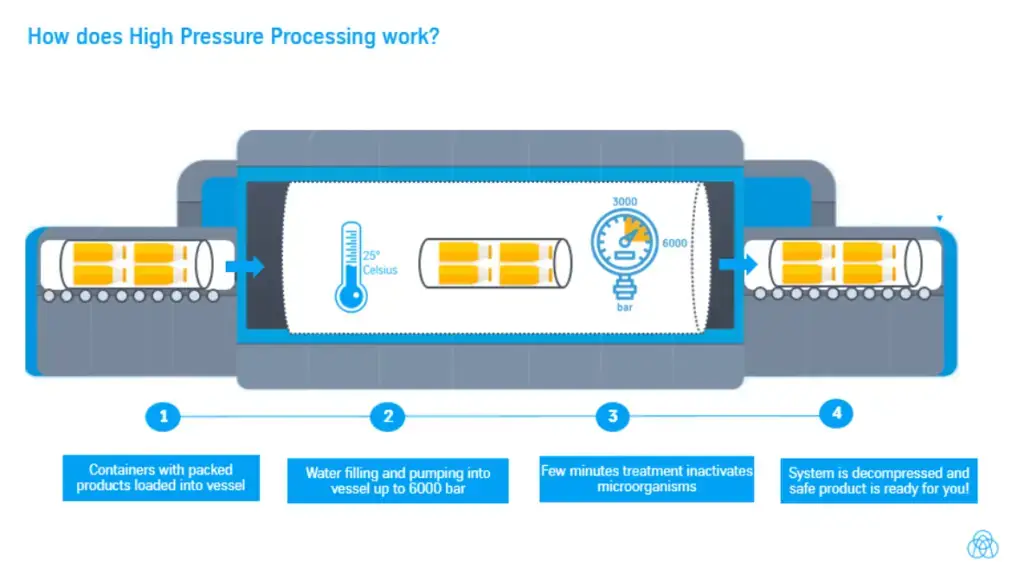
Principle of High-Pressure Processing (HPP)
The principle underlying High-Pressure Processing (HPP) is rooted in the concepts of the Le Chatelier principle and isostatic processing. These principles explain how the application of high pressure affects the behavior of food products.
The Le Chatelier principle states that when pressure is applied to a system in equilibrium, the system will react in a way that counteracts the effect of the pressure. In the context of HPP, this principle means that when high pressure is exerted on a food product, the system of microorganisms, enzymes, and biochemical reactions within the food will react to the pressure. As a result, the volume of the food product decreases under the influence of the high pressure, leading to the inactivation of microorganisms and enzymes.
Isostatic processing is another fundamental principle of HPP technology. It asserts that when a food product is uniformly compressed from all directions with pressure, it will return to its original shape once the pressure is released. This principle highlights the ability of high pressure to uniformly and evenly penetrate the food product, exerting pressure on all sides. This uniform pressure distribution ensures that the food product retains its shape and structure after the high-pressure treatment is completed.
The effects of high pressure on food products encompass various aspects. Microorganisms present in the food, including pathogens and spoilage organisms, are particularly susceptible to the disruptive effects of high pressure. The pressure disrupts the structural integrity and physiological functions of microorganisms, leading to their inactivation and subsequent elimination from the food product.
Moreover, high pressure can also affect chemical, biochemical, and enzymatic reactions within the food. The application of pressure alters the behavior and functionality of biomolecules, which can impact the overall quality, flavor, and texture of the food product. Certain enzymes may become less active or completely denatured under high pressure, thereby affecting the biochemical processes in the food. Additionally, functional properties of biomolecules, such as proteins and carbohydrates, can be modified by high pressure, influencing the overall characteristics of the food.
By leveraging the principles of the Le Chatelier principle and isostatic processing, high-pressure processing achieves its objective of microbial inactivation and modification of food attributes. This innovative technology provides a means to effectively control the microbiological safety of food products while simultaneously offering opportunities to enhance or tailor their sensory properties.
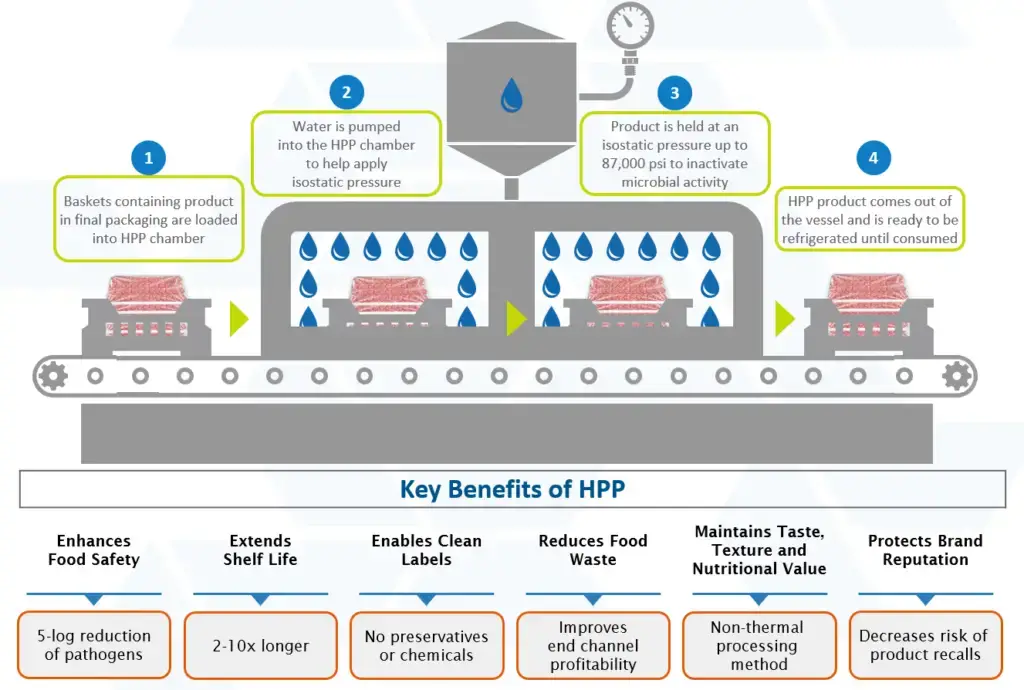
Purpose of HPP treatment
- The purpose of HPP treatment includes:
- Shelf-life extension, such as treating fresh ground beef to extend refrigerated shelf life.
- Achieving technical effects, such as facilitating shell removal in crustaceans.
- Providing lethality treatment, for example, pasteurizing raw milk or reconditioning noncompliant food.
- Supporting reduced monitoring frequencies for specific pathogens in ready-to-eat (RTE) foods, like reducing Listeria monitoring frequency in sliced deli meat.
- Validation requirements for HPP applications:
- Shelf-life extension:
- Validation is not required unless extended shelf life introduces food safety hazards.
- Technical effect:
- Validation is not required for non-food safety purposes.
- Lethality treatment:
- Validation is required to demonstrate the intended reduction in microorganisms is achieved.
- Post-lethality treatment of RTE food for reduced monitoring frequency:
- Validation is required to demonstrate at least a 3-log reduction of Listeria monocytogenes is achieved.
- Treating RTE meat and poultry products for 3 minutes at 87,000 psi (600 MPa) has been validated for Listeria reduction.
- Shelf-life extension:
- Information needed for validation:
- Description of the food item being processed.
- Description of the purpose of the HPP treatment (e.g., shelf-life extension).
- Description of the HPP treatment parameters (e.g., pressure applied, holding time, number of cycles, temperature).
- Justification or data demonstrating the effectiveness of the HPP treatment, including process schedules, shelf-life studies, challenge studies, literature reviews, and manufacturer’s declarations for packaging materials.
- Importer’s responsibility:
- Importers of HPP-treated foods need to obtain necessary information from the foreign manufacturer.
- If validation is required for the purpose of treatment, importers are responsible for providing the required information.
How does High Pressure Processing (HPP) affect shelf life?
High-Pressure Processing (HPP) has a significant impact on extending the shelf life of food products, and the effect depends on various process and product parameters.
When subjected to high pressure and longer holding times, HPP promotes microbial inactivation and reduces enzyme activity. However, the effectiveness of HPP in microbial inactivation can vary depending on factors such as water activity, pH value, and the fat or carbohydrate content of the product. Different microorganisms may exhibit varying levels of barosensitivity in response to HPP.
Additionally, the storage temperature after HPP treatment can influence the shelf life of the product. Proper storage conditions following HPP treatment are essential for maintaining product quality and safety.
In industrial practice, the pressure level and holding time during HPP are carefully optimized to ensure maximum safety without compromising the organoleptic (sensory) and functional properties of the product. This optimization process aims to achieve the desired shelf life extension while preserving the desired characteristics of the food. HPP treatment has been shown to increase the shelf life of fresh products by up to 10 times compared to non-treated products.
Overall, HPP is an effective method for extending the shelf life of food products, allowing for improved safety and longer periods of storage while maintaining the sensory and functional attributes of the treated foods.
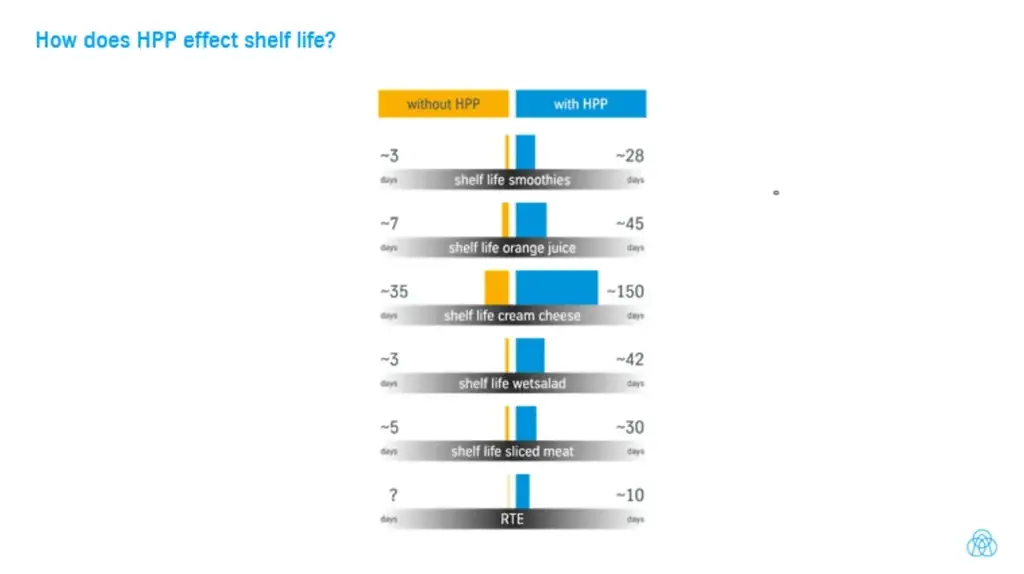
Insturements of High-Pressure Processing (HPP)
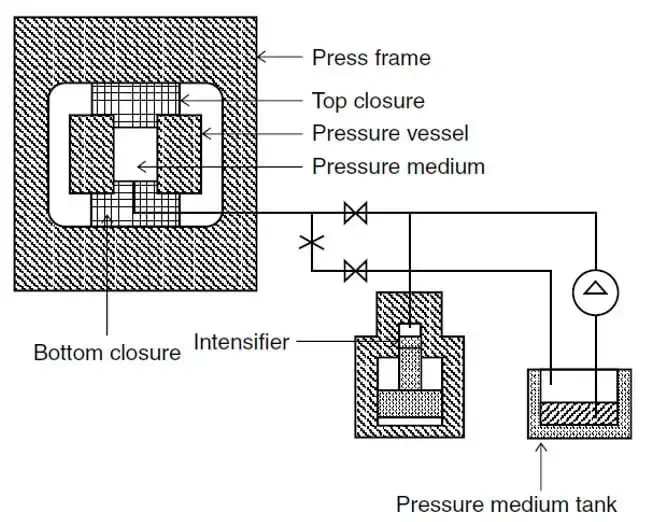
High-pressure processing (HPP) requires specialized instruments and equipment to generate and apply the necessary pressure for the treatment. There are two primary types of compression setups used in HPP, depending on the pressure generation module.
- Direct Compression HPP: In this setup, pressure is generated by moving a small diameter piston through hydraulic pressure, thereby reducing the volume of the system. However, the direct compression method necessitates a high-pressure dynamic seal between the piston and the internal surface of the vessel. This setup is typically employed in laboratory or pilot plant systems where smaller volumes are processed.
- Indirect Compression HPP: The indirect compression system utilizes a high-pressure intensifier to pump the desired pressure from a reservoir into a closed high-pressure vessel. This method is applicable to commercial-scale operations where larger volumes need to be treated. The high-pressure intensifier effectively increases the pressure of the fluid, allowing it to be transferred to the processing vessel.
In addition to the compression setups, there are several key components involved in high-pressure processing systems:
- High-Pressure Vessel and Closure: The high-pressure vessel is a robust and durable container designed to withstand the applied pressures. It is constructed using materials capable of withstanding high-pressure conditions, such as stainless steel or specialized alloys. The vessel is equipped with a secure closure mechanism to ensure the integrity of the system during pressurization.
- Pressurizing System: The pressurizing system is responsible for generating and controlling the desired pressure within the vessel. It may include hydraulic pumps, intensifiers, or other mechanisms capable of creating the required pressure range for HPP. The pressurizing system ensures precise and consistent pressure application throughout the treatment process.
- Heating and Cooling System: Some HPP applications may involve the use of temperature control to achieve specific outcomes. The heating and cooling system allows the high-pressure vessel to be maintained at the desired temperature during the processing. This system ensures that the treatment temperature remains within the defined range, which can be below 0°C or above 100°C, depending on the objectives of the process.
- Materials Handling System: The materials handling system facilitates the loading and unloading of food products into and out of the high-pressure vessel. It may involve conveyors, robotic arms, or other mechanisms to ensure efficient and safe handling of the products throughout the HPP cycle.
- Data Generation System and Microprocessor Controller: To ensure precise control and monitoring of the HPP process, a data generation system and microprocessor controller are utilized. These systems collect and analyze data related to pressure, temperature, and other relevant parameters during the treatment. The microprocessor controller enables real-time adjustments and maintains optimal process conditions based on predefined parameters.
In summary, high-pressure processing (HPP) requires specific instruments and equipment to generate and control the desired pressure. Direct and indirect compression setups are used depending on the scale of operation. Additionally, the high-pressure vessel, pressurizing system, heating and cooling system, materials handling system, and data generation system with a microprocessor controller are essential components in an HPP system. These instruments and components work together to ensure effective and safe high-pressure treatment of food products.
Working mechanism of High-Pressure Processing (HPP)
High-Pressure Processing (HPP) is a food preservation technology that utilizes high pressure to inactivate microorganisms, enzymes, and modify food attributes. The working mechanism of HPP involves several key processes:
- Pressure Transmission: HPP begins by transferring pressure uniformly and evenly to the food product. The high-pressure vessel containing the food is pressurized using hydraulic pumps, intensifiers, or other mechanisms. This pressure is transmitted to the food product, exerting force on all sides.
- Structural Disruption: As pressure is applied, it acts on the food’s cellular structure, disrupting the membranes of microorganisms. The high pressure causes physical stress, leading to structural changes in the microorganisms, including the deformation or rupture of their cell membranes. This disruption compromises their viability and physiological functions.
- Inactivation of Microorganisms: The disruption of cell membranes and other cellular components under high pressure results in the inactivation of microorganisms. This includes both vegetative forms (actively growing and metabolizing) and spores (dormant and highly resistant forms). The pressure-induced damage hampers their ability to grow, replicate, and cause spoilage or disease.
- Enzyme Inactivation: High pressure also affects enzymes present in the food. Enzymes are proteins that catalyze biochemical reactions and contribute to food spoilage and degradation. Under high pressure, the structure and functionality of enzymes can be denatured or altered, leading to their inactivation. This helps preserve the quality and shelf life of the food product.
- Functional Modifications: High pressure can induce functional modifications in biomolecules present in the food, such as proteins and carbohydrates. The pressure alters their conformation, solubility, and interactions, which can affect the texture, flavor, and sensory attributes of the food. These modifications can be leveraged to enhance certain food properties or develop novel food products.
- Uniform Pressure Distribution: Isostatic processing, a principle of HPP, ensures that pressure is uniformly distributed throughout the food product. This uniform pressure distribution allows for consistent treatment effects, minimizing potential variations within the food and ensuring effective microbial inactivation.
It is important to note that the working mechanism of HPP relies on the combined effects of pressure, temperature, and time. Optimal process parameters need to be carefully determined for specific food products and microorganisms to achieve the desired microbial reduction while preserving the sensory and nutritional qualities of the food.
Processing parameters
Processing parameters play a crucial role in High-Pressure Processing (HPP) and can significantly impact the effectiveness and cost of the operation. Here are some key considerations regarding processing parameters:
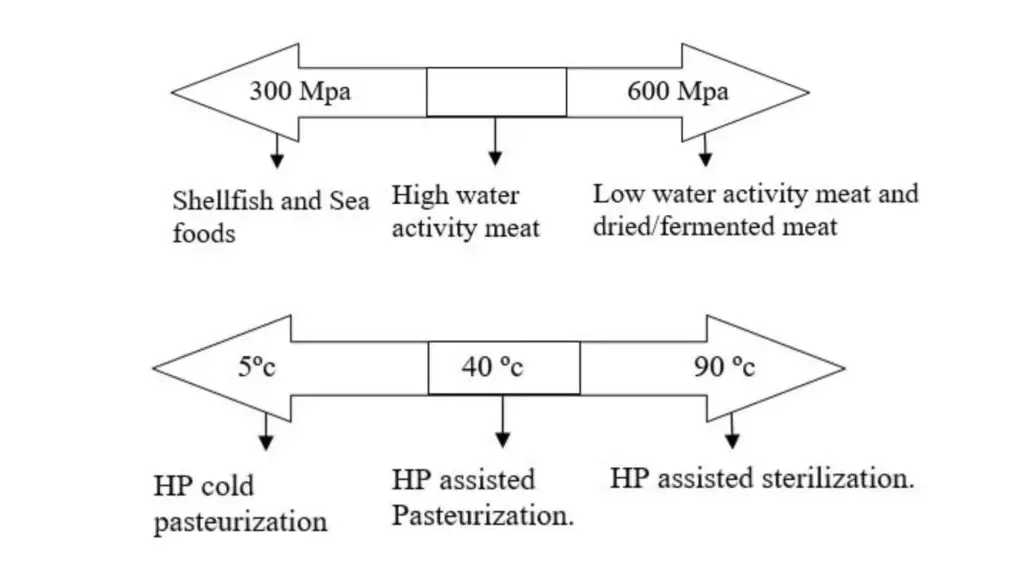
- Cost Factors: The cost of HPP operation can be influenced by the processing time, processing temperature, and processing pressure. Longer exposure times and higher pressures generally require more energy and resources, resulting in increased operational costs.
- Processing Pressure: The range of processing pressure depends on factors such as the water activity and the type of food product being treated. Different microorganisms have varying pressure sensitivities, and the specific pressure required to achieve microbial inactivation can vary accordingly. It is essential to determine the appropriate processing pressure based on the targeted microorganisms and the desired level of microbial reduction.
- Processing Temperature: The processing temperature is determined based on the objective of the HPP treatment. Different temperature ranges are used for specific purposes:
- HP Cold Pasteurization (HP-LT): This process aims to inactivate vegetative pathogenic bacteria and is typically carried out at lower temperatures.
- HP-Assisted Pasteurization and HP-Assisted Sterilization: These processes aim to sterilize low-acid foods and inactivate bacterial spores. Higher temperatures may be employed to achieve these objectives. The selection of the processing temperature depends on the specific food matrix and the target microorganisms.
- Holding Time: The holding time, or dwell time, refers to the duration that the food product remains under pressure in the processing vessel. The holding time depends on various factors, including the type of food matrix and the processing temperature. Optimizing the holding time is essential to ensure effective microbial inactivation while preserving the quality attributes of the food.
- Mode of Operation: HPP can be carried out in batch or semi-continuous mode, depending on the intended application. In batch processing, prepacked foods are loaded into the processing vessel and treated as a discrete batch. Semi-continuous processing involves the continuous flow of pumpable products through the high-pressure system. Industrial HPP systems typically operate in batch processing mode.
- High-Pressure Processing System: HPP systems can be classified into two types based on orientation:
- Horizontal HPP System: In this configuration, the food product is loaded horizontally into the processing vessel, and pressure is applied from the sides.
- Vertical HPP System: In a vertical system, the food product is loaded vertically, and pressure is applied from the top or bottom. The choice of system depends on factors such as the type of food product, processing capacity, and equipment design.
Understanding and optimizing the processing parameters in HPP is crucial for achieving the desired microbial reduction while maintaining the quality and safety of the food product. Careful selection and adjustment of these parameters can help ensure the effectiveness and efficiency of the HPP process.
Steps of High-Pressure Processing (HPP) of Food
High-Pressure Processing (HPP) involves several steps to effectively treat food products. The general steps of HPP are as follows:
- Preparing the Food Product: The first step is to prepare the food product for HPP. This involves selecting the appropriate food items, ensuring they are clean and free from contaminants, and properly packaging them for processing. The packaging must be able to withstand the high-pressure environment without rupturing or compromising the product’s integrity.
- Loading the High-Pressure Vessel: The prepackaged food products are loaded into the high-pressure vessel, which is designed to withstand the high pressures involved in the process. The vessel may be horizontal or vertical in orientation, depending on the specific HPP system being used.
- Sealing the High-Pressure Vessel: Once the food products are loaded into the vessel, it is sealed tightly to create a closed environment. This ensures that the pressure is contained within the vessel during the HPP treatment.
- Applying Pressure: After sealing the vessel, pressure is applied to the food products. The pressure is typically generated using hydraulic pumps, intensifiers, or other pressure-generating mechanisms. The pressure is uniformly distributed throughout the vessel to ensure consistent treatment of the food products.
- Holding Under Pressure: The food products are held under high pressure for a specific period, which is determined based on the type of food, desired microbial reduction, and other factors. Holding times can range from a few minutes to several minutes, depending on the specific application.
- Releasing the Pressure: After the desired holding time, the pressure is released from the vessel. This can be done gradually or rapidly, depending on the requirements of the food product and the HPP system being used. The pressure release is carefully controlled to prevent any sudden changes that could affect the product’s quality.
- Unloading and Packaging: Once the pressure is released, the vessel is opened, and the HPP-treated food products are unloaded. They are then repackaged if necessary for distribution and storage. Proper packaging is essential to maintain the product’s safety and quality during transportation and storage.
It’s important to note that specific HPP systems may have additional steps or variations in the process. However, these general steps outline the fundamental stages of High-Pressure Processing (HPP) for food preservation.
Effect of High-pressure on Microorganisms
- The effect of high pressure on microorganisms varies depending on the type of microorganism and its form, whether vegetative or spore form.
- Pressure sensitivity differs among various types of microorganisms, including those responsible for food poisoning or food spoilage. Gram-positive bacteria tend to be more resistant to pressure compared to gram-negative bacteria. This is attributed to the presence of teichoic acid in the cell wall of gram-positive bacteria, which provides additional protection against pressure-induced damage.
- Spores, which are the dormant and highly resistant form of certain microorganisms, exhibit greater resistance to pressure compared to their vegetative counterparts. Spores contain a compound called dipicolinic acid, which is rich in calcium. This dipicolinic acid plays a crucial role in protecting the spore from excessive ionization and subsequent damage caused by high pressure.
- The presence of dipicolinic acid in spores enhances their resistance to pressure by acting as a stabilizer. It helps maintain the structure and integrity of the spore under high-pressure conditions, preventing the spore from undergoing significant changes or inactivation.
- In contrast, vegetative forms of microorganisms, which are actively growing and metabolizing, are generally more susceptible to pressure. The high-pressure treatment disrupts the cellular structures and functions of vegetative microorganisms, leading to their inactivation and subsequent death.
- The mechanism of microbial inactivation by high pressure involves the disruption of cell membranes, denaturation of proteins, and damage to DNA or RNA. The pressure causes structural changes in these vital components, impairing their functionality and ultimately leading to the inactivation of microorganisms.
- It is important to note that the level of pressure required to achieve microbial inactivation may vary depending on the specific microorganism, its form, and other factors such as the temperature and duration of the high-pressure treatment. The combination of pressure, temperature, and time is carefully optimized to achieve the desired microbial reduction while minimizing any detrimental effects on the quality of the food product.
- Overall, high pressure exerts a significant impact on microorganisms, with spores generally exhibiting greater resistance compared to vegetative forms. Understanding the pressure sensitivity of different microorganisms is crucial for designing effective high-pressure processing parameters to ensure food safety and preservation.
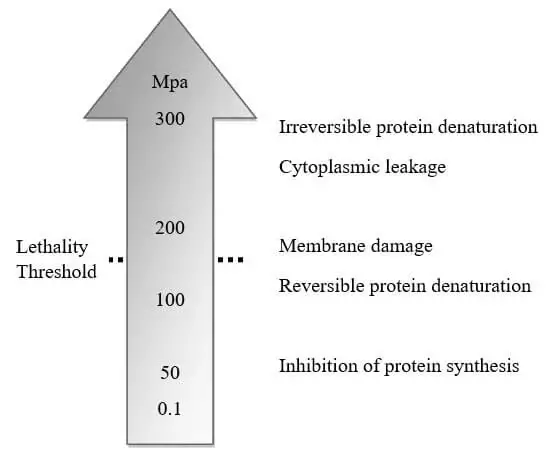
HP processing conditions for Different Bacteria
Different bacteria exhibit varying levels of sensitivity to high-pressure processing (HPP) conditions. Here is a summary of the recommended processing conditions for different bacteria:
- Vegetative Form:
- Processing conditions: Typically, a pressure range of 400-600 megapascals (MPa) is effective in inactivating vegetative forms of bacteria.
- Spore Form:
- Processing conditions: Spores require higher pressures for effective inactivation, often exceeding 1000 MPa.
Specific Bacteria and Recommended Processing Conditions:
- Staphylococcus:
- Processing conditions: In order to achieve significant inactivation of Staphylococcus, pressure levels higher than 500 MPa for a duration of more than 60 minutes are often recommended.
- Processing conditions: A reduction of 6 log cycles (99.9999%) in Escherichia coli can be achieved by applying pressure at 405 MPa for a duration of 10 minutes.
- Saccharomyces cerevisiae:
- Processing conditions: To achieve a reduction of more than 6 log cycles (99.9999%) in Saccharomyces cerevisiae, a pressure of 405 MPa for a duration of 10 minutes is typically recommended.
- Bacillus cereus spore:
- Processing conditions: Bacillus cereus spores require pressure levels higher than 800 MPa for effective inactivation.
- Processing conditions: To achieve a 6 log reduction (99.9999%) in Vibrio parahaemolyticus, a pressure of 200 MPa for a duration of 20 minutes is generally recommended.
- Listeria monocytogenes:
- Processing conditions: For effective reduction of Listeria monocytogenes, a pressure of 340 MPa for a duration of 20 minutes is commonly employed.
It is important to note that these recommended processing conditions may vary depending on specific factors such as the temperature during processing, the presence of other food components, and the desired level of microbial reduction. The given conditions serve as general guidelines for achieving significant microbial inactivation, but it is always advisable to consult scientific literature and conduct appropriate validation studies to determine the optimal HPP conditions for specific bacteria in a particular food system.
Applications of High-Pressure Processing (HPP)
High-Pressure Processing (HPP) is a versatile technology with various applications in the food industry. Here are some common uses of HPP:
- Pathogen Elimination: HPP is highly effective in eliminating pathogenic microorganisms such as bacteria, viruses, and parasites. By subjecting food products to high pressure, HPP can inactivate harmful pathogens, reducing the risk of foodborne illnesses and enhancing food safety.
- Shelf-Life Extension: HPP can extend the shelf life of many food products. By inactivating spoilage-causing microorganisms and enzymes, HPP helps maintain the freshness and quality of foods, allowing them to stay fresh for longer periods. This shelf-life extension can reduce food waste and enhance product distribution and availability.
- Innovative Fresh Products: HPP enables the creation of innovative, minimally processed, and fresh-tasting food products. By using high pressure instead of heat, HPP preserves the natural flavors, colors, and nutritional content of foods, providing consumers with high-quality, minimally processed alternatives.
- Increased Shellfish Yields: HPP is particularly beneficial for the shellfish industry. It helps increase the yields of shellfish by effectively opening the shells without damaging the meat inside. This facilitates easier shucking and improves the productivity and efficiency of shellfish processing.
- Reduced Sodium Products: HPP can contribute to the development of reduced-sodium food products. By applying high pressure, HPP enhances the flavor perception of foods, allowing manufacturers to reduce the amount of added sodium while maintaining taste and palatability. This supports the production of healthier, lower-sodium options for consumers.
- Clean-Label Products: HPP aligns with the clean-label trend in the food industry. It provides a non-thermal, chemical-free preservation method, eliminating the need for artificial preservatives or additives. HPP can help create clean-label products that meet consumer demands for natural and minimally processed foods.
- Convenience: HPP offers convenience in food preparation and consumption. Ready-to-eat meals, deli meats, and other pre-packaged foods can undergo HPP to ensure food safety while maintaining their convenience and on-the-go appeal. HPP-treated products often require minimal or no additional cooking, making them convenient for busy consumers.
Overall, High-Pressure Processing (HPP) provides several advantages and applications in the food industry, including pathogen elimination, shelf-life extension, the creation of innovative fresh products, increased shellfish yields, the development of reduced-sodium options, clean-label products, and enhanced convenience for consumers.
Here are some specific examples of the applications of High-Pressure Processing (HPP) in the food industry:
- Fresh Juices and Beverages: HPP is widely used to process fresh juices and beverages, extending their shelf life while maintaining their nutritional quality and sensory attributes. HPP-treated juices, such as orange juice, apple juice, and cold-pressed juices, remain fresh and flavorful without the need for heat pasteurization or added preservatives.
- Ready-to-Eat Meals: HPP is employed in the production of ready-to-eat meals, including salads, sandwiches, and protein-based dishes. HPP-treated ready-to-eat meals are safe, have an extended shelf life, and maintain the fresh characteristics of their ingredients, providing convenient and healthy options for consumers.
- Guacamole and Salsa: HPP is commonly used to process guacamole, salsa, and other fresh dips. By subjecting these products to high pressure, harmful bacteria are inactivated, extending their shelf life while preserving their fresh taste and texture. HPP-treated guacamole and salsa can be sold as refrigerated products with improved food safety.
- Deli Meats and Seafood: HPP is applied to deli meats and seafood to eliminate potential pathogens and extend their shelf life. HPP-treated deli meats, such as sliced turkey or ham, remain safe and maintain their quality, texture, and flavor. In seafood, HPP is used to improve shucking yields in oysters and clams and to enhance the safety and shelf life of fish and shellfish.
- Baby Food: HPP is utilized in the production of baby food, ensuring the safety and nutritional integrity of purees, fruit blends, and vegetable-based products. HPP-treated baby food products maintain their color, taste, and nutrient content while reducing the risk of contamination by harmful microorganisms.
- Dips, Salsas, and Sauces: HPP is commonly employed in the processing of various dips, salsas, and sauces, including hummus, tzatziki, pasta sauces, and pesto. HPP effectively destroys spoilage microorganisms, extends the products’ shelf life, and preserves their fresh flavor and texture.
- Dairy Products: HPP can be used in the dairy industry for products such as yogurt, cheese, and milk-based beverages. It helps inactivating bacteria and enzymes that can cause spoilage or affect product quality, thus extending the shelf life and ensuring food safety.
These examples highlight the wide range of applications for HPP in different food categories, providing improved food safety, extended shelf life, and enhanced product quality while meeting consumer demands for fresh, minimally processed options.
FAQ
What is High-Pressure Processing (HPP)?
High-Pressure Processing (HPP) is a food preservation technique that uses high pressure to inactivate microorganisms and enzymes, extending shelf life and maintaining product quality.
How does HPP work?
HPP works by subjecting food products to high levels of hydrostatic pressure, typically between 40 and 1000 MPa, which disrupts the cellular structure of microorganisms and enzymes, rendering them inactive.
Is HPP a form of thermal processing?
No, HPP is a non-thermal processing method. It uses pressure rather than heat to achieve microbial inactivation and preserve the freshness and nutritional quality of foods.
What types of foods can be processed using HPP?
HPP can be used to process a wide range of foods, including juices, meats, seafood, dips, sauces, dairy products, ready-to-eat meals, and more.
Does HPP alter the taste, texture, or nutritional content of foods?
HPP has minimal impact on the taste, texture, and nutritional content of foods. It preserves the natural characteristics of the product while providing improved safety and extended shelf life.
Is HPP safe for consumers?
Yes, HPP is considered safe for consumers. It is a non-thermal process that does not require the use of chemical additives or preservatives, making it a natural and safe method for food preservation.
What are the advantages of HPP over traditional food processing methods?
HPP offers several advantages, including extended shelf life, improved food safety, retention of fresh flavors and nutrients, elimination of chemical additives, and minimal impact on product quality.
Can HPP be used to replace heat pasteurization methods?
Yes, HPP can be used as an alternative to heat pasteurization methods in certain applications. It provides a non-thermal option for achieving microbial reduction and preserving the sensory attributes of foods.
Does HPP eliminate all microorganisms in food?
HPP is highly effective in reducing the microbial load in food, including pathogenic bacteria. However, it is important to follow proper handling and storage practices to maintain food safety after HPP treatment.
Can HPP be used in combination with other food processing technologies?
Yes, HPP can be used in combination with other food processing technologies, such as heat treatment, to achieve desired results. This allows for customized processing approaches to meet specific food industry needs.
References
- Potter NP (1987), Food Science, CBS Pub, India
- Balasubramaniam, V.M., et al. (eds.) (2015). High Pressure Processing of Foods. Springer. DOI: 10.1007/978-1-4939-1550-9.
- Knorr, D. (ed.) (2002). Novel Food Processing Technologies. CRC Press. ISBN: 978-0849308878.
- Patterson, M.F. (2005). Microbiology of Pressure-Treated Foods. Journal of Applied Microbiology, 98(6), 1400-1409. DOI: 10.1111/j.1365-2672.2005.02581.x.
- López-Malo, A., et al. (eds.) (2018). High Pressure Processing of Food: Principles, Technology and Applications. Woodhead Publishing. ISBN: 978-0081003052.
- Rahman MS (1999), Handbook of Food Preservation, Marcel Dekker, Inc, NY
- Balasubramaniam, V.M., et al. (2015). High Pressure Processing: Effects on Bioactive Compounds and Food Safety. Annual Review of Food Science and Technology, 6, 435-462. DOI: 10.1146/annurev-food-022814-015717.
- Huang, H.W., et al. (2018). Recent Advances in High-Pressure Processing for Food Industry. Food Control, 94, 224-240. DOI: 10.1016/j.foodcont.2018.07.009.
- Buckow, R., et al. (2013). High Pressure Processing (HPP) of Food: Microbiological and Food Safety Aspects. Food Science and Technology International, 19(6), 477-490. DOI: 10.1177/1082013212470813.
- Ortega-Rivas, E. (ed.) (2018). High Pressure Processing of Food: Principles, Technology, and Applications. CRC Press. ISBN: 978-0367390683.
- Desrosier EN (1963), The Technology of Food Preservation, AVI Publishing Company, New York










